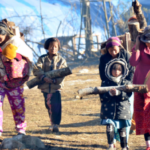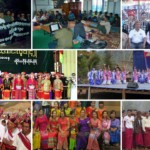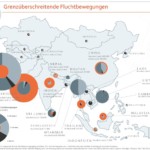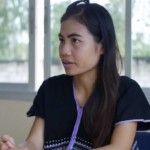By Victoria Milko / Frontier Myanmar | November 20, 2017
Food aid cuts have created further anxiety for more than 6,000 refugees and displaced people from Shan State who have endured a precarious existence for years in camps along the Thai-Myanmar border.
CAREFUL TO avoid the gaze of the Thai soldiers at their border post less than 100 metres away, Sai Ba Tha, 37, a medic and English teacher at the remote Loi Kaw Wan internally displaced persons camp, lifted a burlap cover protecting a small stack of bags of rice.
The rice, which was privately donated to the camp in Shan State, opposite Thailand’s northernmost province of Chiang Rai, was the only food the camp had received since October 1. That was when funding shortfalls forced The Border Consortium, a donor-funded alliance of INGOs, to cut all food aid to the IDP and refugee camps on the Shan State-Thailand border and another in Kayin State.
“This is all we have left,” Ba Tha told Frontier on October 31, 2017. “After this we have nothing. We don’t know what’s going to happen.”

Loi Kaw Wan is one of five IDP camps on the Myanmar side of the border and there is a refugee camp, Koung Jor, in Chiang Mai province.
The first camps were established along the border in the late 1990s as thousands of villagers fled Shan State to escape a scorched earth campaign launched by the Tatmadaw that was accompanied by allegations of atrocities and other human rights abuses.
The Tatmadaw launched the campaign in 1996 to crush the newly-formed Restoration Council of Shan State and its armed wing, the Shan State Army-South.
 Sai Leng, 48, sits in front of the Loi Kaw Wan medical facility. He lost his hands in a land mine blast while fleeing Myanmar. (Victoria Milko | Frontier)
Sai Leng, 48, sits in front of the Loi Kaw Wan medical facility. He lost his hands in a land mine blast while fleeing Myanmar. (Victoria Milko | Frontier)
The Shan Human Rights Foundation, a civil society group, says more than 300,000 people were forced from their homes between 1996 and 1998, and more than 600 civilians were killed.
In their 2002 report, Licence to Rape, the SHRF and another civil society group, the Shan Women’s Action Network, documented more than 600 accounts of rape and sexual violence against women in the late 1990s, mostly in areas of Shan where forced relocations occurred.
In late 1999 under the pretext of eradicating opium poppy cultivation, the junta began to resettle Wa villagers from northern Shan along the border with China to areas in the south of the state near the Thai border where the soil is fertile. It was at this time that the first IDP camp was established on the border, but more were soon needed.
 Medical facilities at the Loi Kaw Wan IDP camp. (Victoria Milko | Frontier)
Medical facilities at the Loi Kaw Wan IDP camp. (Victoria Milko | Frontier)
Between 1991 and 2001 more than 126,000 villagers were moved from six Wa townships to southern Shan, creating serious hardship and disruption to the area’s mainly Shan, Lahu and Akhu communities.
In 2001, fighting erupted between the Shan State Army-South and the Tatmadaw, which was being supported by the United Wa State Army. The Tatmadaw and the UWSA allegedly harassed and persecuted Shan villagers suspected of supporting the Shan State Army-South. Among the thousands of Shan who fled to the Thai border, leaving their villages and property to be seized by the UWSA, were those who established Loi Kaw Wan IDP camp.
 RCSS/SSA regional eastern commander Sao Kon Zuen. (Victoria Milko | Frontier)
RCSS/SSA regional eastern commander Sao Kon Zuen. (Victoria Milko | Frontier)
As the Tatmadaw’s forced relocations continued, more camps were established on the Thai side of the border. The Thai authorities refused to tolerate the camps and ordered their demolition and relocation to the Myanmar side of the border. Some camps built on the Myanmar side were later forced to relocate to sites where they could not be seen from Thai territory.
The camps today
Nearly two decades after the first camp was set up, the six camps house more than 6,000 people. More than half of the camps’ residents are women, and 39 percent are aged under 18. All camp residents are reliant on food aid to survive.
A visit to the camps quickly makes clear that foreign donors, including governments, and INGOs have played a crucial supporting role. Many of the camps have playgrounds, schools, and medical clinics bearing the names of private donors and foreign aid groups. There are solar panels on the thatched roofs of some residents’ homes, which always seem to have at least one fat chicken clucking in their front garden.
 However, many of the buildings in the camps have been affected by the passage of time, and the elements. A rice barn rattled by an earthquake years ago rests shakily on its foundations; some schoolrooms have holes in walls and roofs from weather damage but cannot be repaired without access to supplies or funding. A basketball backboard sits at one end of a makeshift dirt court, with the remains of a hoop that succumbed to rust several rainy seasons ago.
However, many of the buildings in the camps have been affected by the passage of time, and the elements. A rice barn rattled by an earthquake years ago rests shakily on its foundations; some schoolrooms have holes in walls and roofs from weather damage but cannot be repaired without access to supplies or funding. A basketball backboard sits at one end of a makeshift dirt court, with the remains of a hoop that succumbed to rust several rainy seasons ago.
However, infrastructure is not the most urgent problem facing the camps.
The food aid cuts, which The Border Consortium says were announced in February, have created a crisis for residents since they took effect on October 1, with few options for relief.
“The most common responses from the Shan community are disappointment that food aid has stopped, frustration that the peace process has not improved prospects for return, and anxiety about their capacities to be self-reliant,” said Mr Duncan McArthur, the Myanmar programme director of TBC, which was established in 1984 to help refugees along the Thai side of border. TBC provides assistance to a series of camps opposite Kayah and Kayin states that house about 100,000 people.
Shan camp leaders say they have been working to establish self-reliance for more than a decade. Vegetable gardens have been established at camps where the soil is arable, but most are in areas where it is not possible to grow rice, a staple of their diet. This means that camp residents need to find jobs to support themselves and their families. But opportunities for work are limited.
“A few times a year we go to the garlic farms in Thailand to try and earn money,” said Sai Ba Kham, 52, a resident of the Koung Jor refugee camp. “Even though it’s illegal and we might be arrested, we have to do it. Otherwise we will have no way to buy food to survive.”
It’s common for the garlic, tea and orange farms in areas near the camps to hire their residents, even though it is illegal because most refugees and IDPs lack identification and work permits. The farm owners pay workers from the refugee and IDP camps about one-third of what they pay Thai labourers, who earn about 200 baht (K8,200) a day.
Camp residents say they could make a reasonable living if they worked every day but crop cycles mean that opportunities for permanent work are limited. Those who do find jobs risk being arrested and face the possibility of being jailed and then sent back to Myanmar.
Camp leaders said that with few options to earn money to buy food, children are increasingly pressured by their families to drop out of school to earn what meagre amounts they can, or stay home and care for siblings while both parents seek work.
“It’s become a problem for every family in the camp,” said Sai Peng, a leader at Loi Kaw Lan IDP camp. “We’re trying to solve the food problem, but there’s only so much we can do.”

The unofficial status of the camps poses other challenges for the IDPs and refugees.
Many of the camps can provide only basic health care and rely on limited supplies of donated medicine and equipment. Pesticides used in the tea plantations have caused skin ailments that are often difficult to treat. A cancer diagnosis effectively amounts to a death sentence and mental health problems are on the rise. The SHRF said there had been two suicides in the past two months and both were linked to the decision to cut food aid.
“Having a healthy baby here is difficult, too,” said heavily pregnant Loi Kaw Wan resident Nang Shi Mi, 20, as she sat at home waiting for her husband to return from a rare day’s work at a tea plantation. “Going to the Thai hospital takes many hours, costs lots of money, and there’s the risk of being arrested. I worry, but I know I have to do it for the health of my baby,” Shi Mi told Frontier. She also worries that her children will become malnourished because of the food aid cuts.
 Loi Kaw Wan camp resident Si Tong, 29, sits in front of her home. Si Tong is pregnant with her third child and worries about getting enough food to keep her baby healthy. (Victoria Milko | Frontier)
Loi Kaw Wan camp resident Si Tong, 29, sits in front of her home. Si Tong is pregnant with her third child and worries about getting enough food to keep her baby healthy. (Victoria Milko | Frontier)
Shi Mi’s situation is not unique. Camp leaders say women often need to be taken to Thai hospitals after going into labour. In the rainy season the journey involves negotiating unpaved, mountain roads turned to mud. Elders at Loi Kaw Wan told Frontier of women who had lost their child during the journey to hospital.
“The people suffering the most will be children, old people, and those that are pregnant,” said Tai Peng, the Loi Kaw Wan camp leader. “Those people are who we worry about and who will be hurt the most.”
The road home
Spend a few minutes talking with camp leaders and the conversation quickly turns to Myanmar’s peace process. There is disappointment that there has not been greater progress since the National League for Democracy government took office 19 months ago under State Counsellor Daw Aung San Suu Kyi.
“Before, we had hope that Aung San Suu Kyi’s government would make our lives better, but it seems that is not a reality or as we hoped,” said Tai Peng. “We can now see that the army has more power than her. We think she won’t have enough power to support all the people and control all the land in Burma.”
As well as fading hopes about the peace process, camp residents worry about not having identification papers to ensure a smooth return to Myanmar when that eventually becomes possible. Many who fled their villages during the Tatmadaw’s scorched earth campaign had never applied for national identity cards, and those who did have citizenship identification say they were forced to abandon their possessions during military clearance operations in their villages.
 Loi Kaw Wan camp has the largest poulation of all the Shan refugee/IDP camps. (Victoria Milko | Frontier)
Loi Kaw Wan camp has the largest poulation of all the Shan refugee/IDP camps. (Victoria Milko | Frontier)
Some camp residents say that even if their safety was guaranteed and they were issued with ID cards, they have no home to which they can return.
“We want to go home, but even if we do we have no land, it has been taken by the military,” said Sai La Wan, a community leader at Loi Kaw Wan.
“Our homes are now occupied by different groups. It would be very difficult to go back; we’d have to buy our own land back.”
 Tatmadaw outposts in the mountains close to territory controlled by the RCSS/SSA. (Victoria Milko | Frontier)
Tatmadaw outposts in the mountains close to territory controlled by the RCSS/SSA. (Victoria Milko | Frontier)
Communities in Shan are also threatened with further disruption by plans for megaprojects, including a series of hydropower dams along the Thanlwin (Salween) River.
They include a project by Thailand and China to build the massive Mong Ton dam on the Thanlwin in eastern Shan. Also known as the Tasang dam, civil society groups say that if completed, the 7,000-megawatt project would displace between 200,000 and 300,000 people.
“Dams on the Salween affect the areas where the refugees come from,” said Nang Charm Tong, founder of the Shan Women’s Action Network, at a panel discussion at the Correspondent’s Club of Thailand in Bangkok last month. “If such projects are built there is no way that the refugees can go back; there is no home for them to return to,” she said.
 A poster protesting a dam on the Thanlwin River hangs in a meeting room in Loi Kaw Wan camp. Megaprojects like the dam threaten to displace more residents in Shan State. (Victoria Milko | Frontier)
A poster protesting a dam on the Thanlwin River hangs in a meeting room in Loi Kaw Wan camp. Megaprojects like the dam threaten to displace more residents in Shan State. (Victoria Milko | Frontier)
Although there are reports that a coal mine and power plant planned by military-owned Myanmar Economic Corporation and the Italian-Thai Power Co at Mong Kok in eastern Shan has been halted, Charm Tong said recent arrivals at the Shan IDP camps say villagers are still being forcefully cleared from the project area.
During the discussion about these concerns at a school room at Loi Kaw Wan, the participants were quiet for a moment. “It’s so sad when we talk about these things,” said community leader Sai Pun Pun Lat, as other camp leaders lowered their heads and solemnly nodded in agreement.
Few alternatives
Providing a month’s supply of food – 16 kilograms of rice, 100 grams of salt, 100g of chilli, and a litre of cooking oil – costs about US$11 (nearly K15,000) a month a person. That means $70,000 a month, or about $820,000 a year, would be enough to feed each resident of the six camps. But that aid has not materialised.
“It’s always a challenge to raise funds for food aid in a situation of protracted displacement where needs are chronic but not life threatening,” said McArthur. “It’s even more difficult when the light at the end of the tunnel is blurred because the return and resettlement of displaced communities does not seem a priority for either the government of Myanmar or the respective ethnic armed organisations.”
But many camp leaders and residents worry that halting the food aid, upon which they have relied heavily for years, could be life threatening because of the lack of alternative resources. A local donation to Loi Kaw Wan enabled each family there to receive one 5kg bag of rice to last them until the end of October.
 Thai vendors come to the Koung Jor refugee camp early in the morning to sell food and other supplies. (Victoria Milko | Frontier)
Thai vendors come to the Koung Jor refugee camp early in the morning to sell food and other supplies. (Victoria Milko | Frontier)
Delivering local donations can be problematic because sending goods to the camps from the Thai side must be arranged in advance with the Thai military.
“A truck with a private aid donation came this month but was turned away by the Thai army,” said Ba Tha. “The donors didn’t arrange ahead of time, so the aid wasn’t allowed to come through until days later.”
Until more aid arrives, camp residents say they will get by as best they can but fear for the future as they have no ID cards, little or no education, and are afraid to go home. For some, life in the camps is all they know.
In October, State Counsellor’s Office spokesman U Zaw Htay was quoted as saying that the government would provide aid to displaced Shan refugees.
 Children in a classroom at a school near the Koung Jor refugee camp. (Victoria Milko | Frontier)
Children in a classroom at a school near the Koung Jor refugee camp. (Victoria Milko | Frontier)
In a statement released on October 31, the Shan State Refugee Committee, a civil society group, said it had not been contacted directly by the government.
It doubted the sincerity of the offer, saying it “appears to be a publicity stunt to divert attention from the Burma Army’s ongoing military operations systematically depopulating Burma’s ethnic states”. The statement added: “The Burmese government’s offer to assist the displaced Shan, while keeping silent on the Burma army’s ongoing systematic crimes, thus rings hollow indeed.”
As of the first week of November, Koung Jor camp leader Sai Leng said that, to his knowledge, no one in the Shan refugee community had been directly contacted by the State Counsellor’s Office regarding aid.

There is also speculation that the humanitarian crisis in Rakhine State has further diverted attention from Myanmar’s eastern border.
A woman at Loi Kaw Wan who was asked if she thought the situation in Rakhine would affect aid for the Shan camps responded with a blank stare.
“She doesn’t know what’s going on there,” another camp resident said, answering on her behalf. “She doesn’t worry about politics, she worries about making sure she has food to survive.”
A distant demonstration
On October 29, a month after the food aid cuts took effect, thousands of people gathered in Yangon to show their support for the Tatmadaw after it came under international criticism over its counter-insurgency operation in Rakhine. Members of the crowd praised the Tatmadaw for its role in protecting national sovereignty, ethnic groups, races and religion.
More than 1,000km away at Loi Kaw Wan, camp leaders grimaced and shook their heads when they saw images of the demonstration.
“Really if
Looking beyond the man’s shoulder, past a near-empty food store to the nearby mountains where several Tatmadaw posts can be seen dotted along the hills, it’s hard to disagree.
This article originally appeared on Frontier Myanmar on November 20, 2017.







